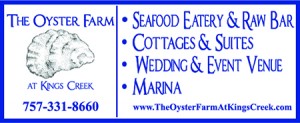ALTERNATIVE TABLE
A Visit to the Upshurs’ Copper Cricket Farm
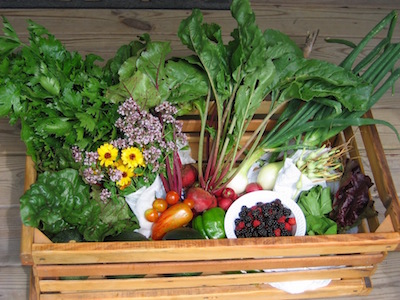
Late June basket from Copper Cricket Farm. (Photos: Karen Gay)
By KAREN GAY
Cape Charles Wave
June 8, 2015
Small sustainable farms are on the rise in America and even on the Eastern Shore. Every time I go visit a new farm on the Shore the farmers point me to yet another farm I haven’t heard about. As part of my Weston A. Price Chapter Leader responsibilities I have compiled a list of great places to get fresh, local and often organic food. As this list is growing, my goal is to visit each farm or market on the list so that I can explain to readers the hallmarks of each one. I will be happy to email the resource list to you ([email protected]) or you can pick one up at the Tall Ships Festival where I will have a Weston A. Price booth.
Surprisingly, I have found that some of the farmers I’ve visited have started their farms in mid-life. This is the case with the farmers of Copper Cricket Farm, Carol and Arthur “Cricket” Upshur. Cricket was raised on the Shore and graduated from Broadwater Academy. He met Carol in college and they raised their three children while moving frequently. Cricket spent much of his career working at Groupe Danone, a large French food company. It was probably their time in France that crystalized their views on good food and natural food products. [Read more…]
ALTERNATIVE TABLE: Strawberry Fields Forever
 By KAREN GAY
By KAREN GAY
Cape Charles Wave Columnist
June 1, 2015
Last spring while my friends were gorging on juicy, sweet strawberries I was supine on my zero-gravity recliner recovering from 35 years of sitting at a desk. This year, feeling much better, I determined to find that farm that everyone talked about but no one could quite explain exactly where it was. Asking one friend, I heard “Oh, it’s just a ways up 13.” Another friend looked at me blankly when I asked whether it was north or south of OBS Building Supply. Someone told me it was before you hit Exmore. “Well, is it before or after the Machipongo Trading Company?” She couldn’t say.
So on a sunny Saturday I set off north from Cape Charles to find these ephemeral strawberry fields where everyone in town went, but where no one could identify its location. Lo and behold, just a short distance north of Eastville the fields appeared just after Union Baptist Church. I swung right into Bell Lane and parked in the grassy lot to the side of the farm stand. As soon as I opened the car door I could tell there were strawberries nearby. The scent wafted over me as I approached the stand and then it only got better as Janice Giddens welcomed me with a huge smile and bright pink stained hands. She and two others had been in the back of the stand packing strawberries into quart containers. I bought two quarts and asked if I could interview her. She deftly pointed me out to the fields to question the boss who was in a red shirt. [Read more…]
The Alternative Table: Willowdale Farm
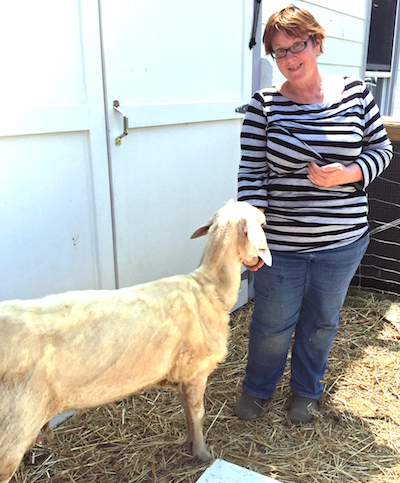
Catherine Harrison with her milking sheep Portia. (Photos: Karen Gay)
By KAREN GAY
Cape Charles Wave
May 18, 2015
Catherine Harrison, of Willowdale Farm in Painter, is an unexpected cross between a mad scientist and a business executive. Looking at her land, you’d think that there isn’t much farming going on there, but what she is growing blends in with the green pastures full of what we might call weeds: chicory, clover, and grass.
She produces a line of skin care products called Celluvati, which she coined from the word “cell” and the Sanskrit word “uvati,” which means young, beautiful woman. Her prize ingredient is the orange Sea Buckthorn berry, which grows on a distinctive herb with long and narrow dusty green leaves. The berries are known for preventing infections, improving sight, and slowing the aging process. The plant in the photo below is a Sea Buckthorn (but there are no berries on this one).
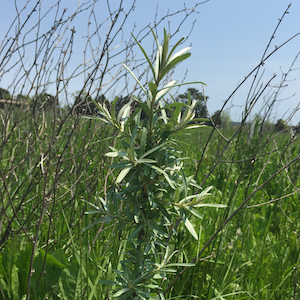 There is a full line of Celluvati products which Catherine offers on the web at celluvati.com. Products include moisturizers, eye creams, a serum, balm, and aftershave. I can attest to the lovely scent in the balm.
There is a full line of Celluvati products which Catherine offers on the web at celluvati.com. Products include moisturizers, eye creams, a serum, balm, and aftershave. I can attest to the lovely scent in the balm.
There is more to this farm than sea buckthorn, though. She has planted 250 Chinese chestnut trees and 250 native persimmons onto which she has grafted Japanese persimmons. There are goumi shrubs and elderberries. The goumi produce red berries with silver spots which can be eaten as a fruit or used as a botanical in future skin care products as they contain vitamins, flavonoids, and other bio-active compounds. Elderberry is also full of minerals and vitamins, particularly vitamin B17. The flowers can be used for tea, and the berries can be mashed for juice or used as a tonic for colds and flu. Elderberry is the source of the natural preservative used in the Celluvati products. [Read more…]
ALTERNATIVE TABLE
Fresh Eggs and More at La Caridad Farm
 By KAREN GAY
By KAREN GAY
Cape Charles Wave
May 11, 2015
It was one of the few sunny spring days when Luis Echevarria and I wandered down the grassy path towards the poultry enclosure at the 40-acre La Caridad Farm in Parksley. As we approached, I noticed a large white goose honking furiously at us. This is a goose with the job of guarding the ducks — and he works for food.

(Photos: Karen Gay)
Luis explained that several days before, this goose bit his wife Stacia Childers’ leg, causing a large and painful bruise. Since introducing the goose to the flock they have not lost any to predation. The well-guarded ducks are Welsh Harlequins, which weigh about 5 pounds and lay an egg almost every day. Their eggs are larger than chicken eggs, but Luis prizes them mostly for their richness. When Stacia joined us she kept her distance from the goose.
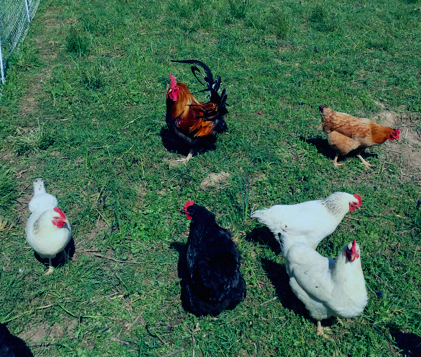 The chickens are in an adjoining enclosure and are of varied breeds. The rooster shown at right is a Dorking, the white hens are Delawares, the brown hen is a New Hampshire and the black hen is an Australorp. They also have Easter Egg layers or Ameraucanas, which produce green, olive, blue or pastel colored eggs.
The chickens are in an adjoining enclosure and are of varied breeds. The rooster shown at right is a Dorking, the white hens are Delawares, the brown hen is a New Hampshire and the black hen is an Australorp. They also have Easter Egg layers or Ameraucanas, which produce green, olive, blue or pastel colored eggs.
Luis and Stacia gave me a dozen eggs to take home with me and I ran a test a few days later. I borrowed an egg which had come from regular Food Lion eggs. I photographed the La Caridad and Food Lion egg side by side. Can you guess which one came from La Caridad? The answer is at the bottom of the article. [Read more…]
ALTERNATIVE TABLE: Fat and Scientific Shenanigans
By KAREN GAY
Cape Charles Wave Columnist
March 30, 2015
In my article of last week, I featured the Weston A. Price Foundation (WAPF) and described how their recommended traditional diet helped me lose 50 pounds over nine months by changing my fat intake to greater than 30 percent of calories coming mostly from saturated and monosaturated fats.
 As I lost my food cravings I began to do research on fat and its impact on one’s body. How could it be that for over 40 years the U.S. Department of Agriculture (USDA) was a strong proponent of low fat diets?
As I lost my food cravings I began to do research on fat and its impact on one’s body. How could it be that for over 40 years the U.S. Department of Agriculture (USDA) was a strong proponent of low fat diets?
In 1968, after seeing an image of a child who had died of starvation in the CBS documentary, Hunger in America, George McGovern became the chair of the “Select Committee on Nutrition and Human Needs” with the goal of wiping out hunger and malnutrition in the United States. In 1977 the Select Committee published the “Dietary Goals for the United States” after hearing Dr. Ancel Keys and other supporting researchers speak about the link between saturated fat and cholesterol consumption.
From 1972 to 1973 and concurrent with the Select Committee, the American Heart Association, American Medical Association, and the National Academy of Science developed the following recommendations:
- Americans’ cholesterol is too high;
- We should measure our cholesterol in medical examinations;
- People considered as “at risk” should receive appropriate dietary advice;
- At risk Americans should reduce their intake of saturated fat by substituting polyunsaturated vegetable oils;
- Modified and ordinary foods (to support the ingestion of vegetable oils) should be available in the marketplace; and
- More studies should be performed to determine if lowering cholesterol can reduce chronic heart disease.
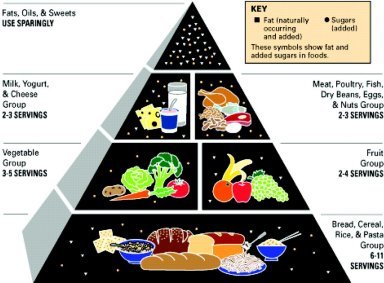 The piling on the bandwagon by these organizations led to the 1992 USDA Food Pyramid that most of us remember so well.
The piling on the bandwagon by these organizations led to the 1992 USDA Food Pyramid that most of us remember so well.
So how did all of these organizations arrive at these conclusions? I believe it was the work of Ancel Keys in the 1950s that started the idea that saturated fat led to the increase in heart disease. He noticed that death from heart disease dropped in areas where food rationing had been in place due to WWII and increased in industrialized areas of the world. Keys created graphs using food intake data and mortality statistics from the late 1940s using six countries: Japan, Italy, England, Australia, Canada, and the USA. The data appeared to show a correlation between the ingestion of fat and the increase in heart disease. We now call this the Diet-Heart Hypothesis which puts forward the idea that saturated fat causes cardiovascular disease (CVD) by raising blood cholesterol. He presented a graph at the 1955 World Health Organization conference that mapped fat intake to each country’s rate of death from heart disease. [Read more…]
THE ALTERNATIVE TABLE: How I Lost 50 Pounds
By KAREN GAY
Cape Charles Wave Columnist
This is the first of a series of columns I am calling The Alternative Table. I will discuss many topics beginning with interviews and photos of some of the new sustainable farms on the Eastern Shore and also covering what are healthy food choices and cooking techniques, recipes, important books and movies on these subjects, and alternative health options. I’ll approach these subjects from the point of view of a journalist, reporting on farms I’ve visited and topics I’ve been reading about. I’d like to be clear about the fact that I am a layperson with wide-ranging interests in these topics and not a doctor, nutritionist, or healer.
My first topic is the Weston A. Price Foundation and how it has helped my health. I understand that what has worked for me is not necessarily a weight loss solution for everyone. We all come from different genetics, cultural heritages, and physical experiences, and as a result each of our bodies operates in a slightly different manner.
At first, my friends looked at me incredulously when I explained how I lost 50 pounds by incorporating the principles of the Weston A. Price Foundation. The ingredient that did it for me was fat — lots of fat! Like most people coming of age in the 1970s I learned about the new USDA food pyramid and the need to eat less meat, dairy, and fat. I took this seriously, as my mother had always kept abreast of health trends, listening to Carlton Fredericks and Adele Davis on the radio. My siblings and I were probably the only children who went to school after a breakfast of orange juice and brewer’s yeast. Fortunately, the niacin flush wore off just as I arrived at school.
Fast forward past high school, college, marriage, kids, and a career. By the time I retired in April 2014 I was physically exhausted from raising children, coping with a really stressful career spent mostly in front of computers in dark rooms, and a commute that took occasionally more than two hours on the return trip. I was way overweight, exhausted, and my preference during non-work days was to read in bed. Somehow over the years when initially I tried to make healthy food choices I stopped reading labels and bought food primarily for convenience. I found myself looking forward to meals and snacks as replacements for fun and over time began to crave sugar and then fat alternately.
Once I got those cravings, it got to be an addiction. My drugs of choice were potato chips followed by ice cream. No matter how each day I resolved to skip the grocery store, by the time I finished work I could not resist. At the time I knew I had a problem but did not know how to resolve it. For quite a few years I was convinced that I just lacked willpower. [Read more…]





